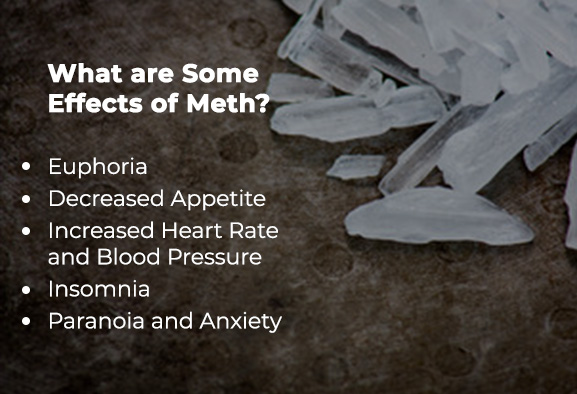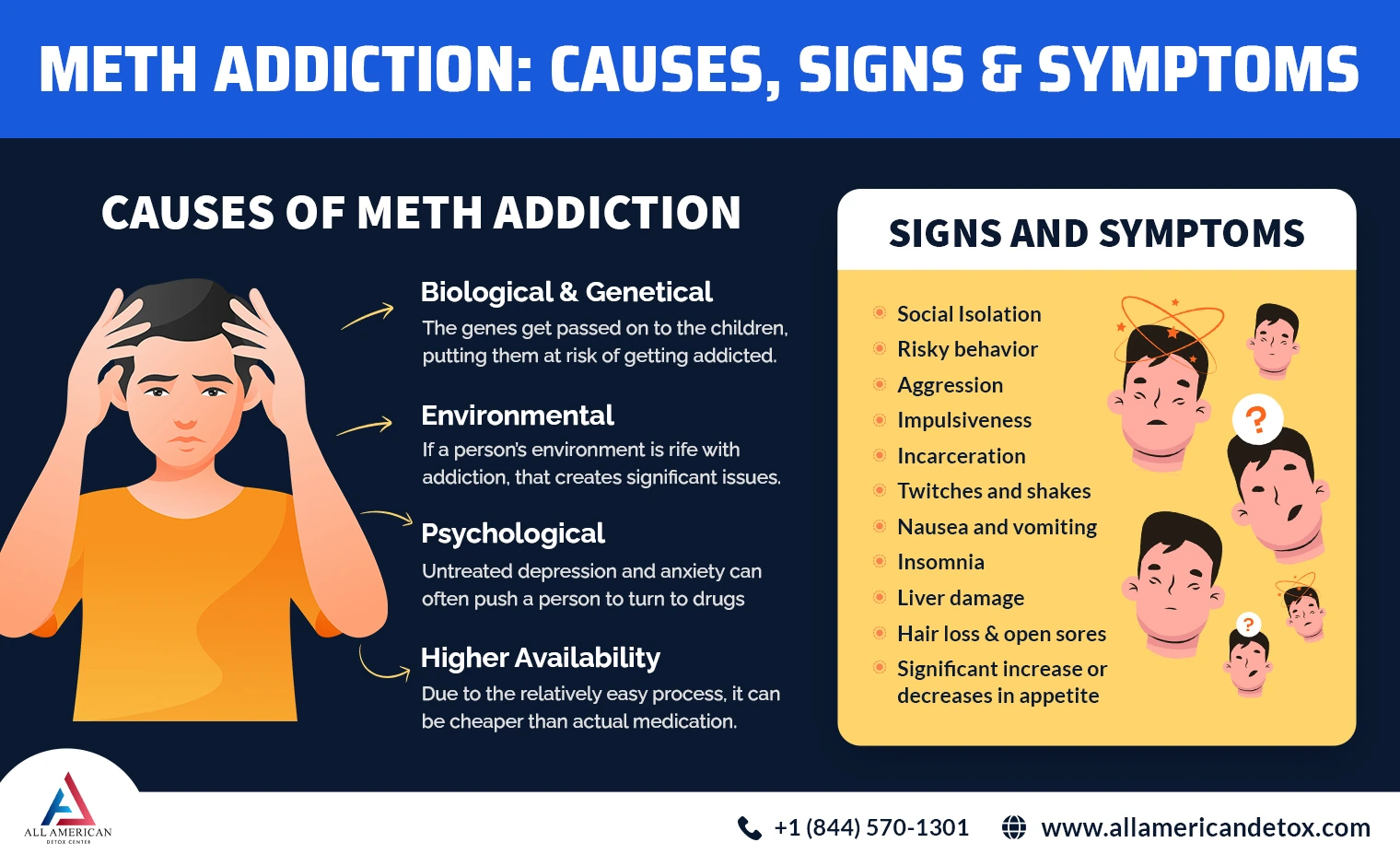Methamphetamine, commonly referred to as meth, is a powerful central nervous system stimulant that is widely known for its addictive properties and detrimental effects on health.
Understanding the nature of methamphetamine, its effects, and how it interacts with the body is crucial for addressing the challenges associated with its use and abuse.
At the end of this blog, you will have an idea of “How long does Meth stay in your System?”
So, let’s get started.
What is Methamphetamine?
Methamphetamine is a stimulant drug that is chemically similar to amphetamine, a medication used to treat ADHD and narcolepsy. However, methamphetamine has a much higher potential for abuse and addiction.
It stimulates the brain by increasing the release of dopamine, a neurotransmitter associated with pleasure, movement, and motivation.
People typically use methamphetamine for its intense euphoric effects, but its use comes with severe risks and consequences. Methamphetamine can be found in various forms, such as powder, crystals, or pills, and it is commonly abused for its stimulant effects.
How Long Does Meth Stay in Blood?
Methamphetamine typically stays detectable in the bloodstream for up to 1-3 days after use. However, this duration can vary depending on factors such as the individual’s metabolism, frequency of use, and the amount ingested. Blood tests are commonly used to detect recent methamphetamine use in forensic and medical settings.
How Long Does Meth Stay in Urine?
Methamphetamine can be detected in urine for a longer duration compared to blood, typically ranging from 3 to 5 days after use. Like blood tests, urine tests are frequently employed for drug screening purposes due to their non-invasive nature and ability to detect drug metabolites.
(Read the blog on Hashish Effects)
What are Some Different Types of Meth?
Methamphetamine, commonly known as meth, is available in various forms, each with its characteristics and methods of use. Understanding the different types of meth can provide insight into the diverse ways in which this substance is produced and consumed.
Here are some of the most common forms:
Crystal Methamphetamine (Crystal Meth):
This form of methamphetamine is crystalline in appearance and is typically smoked, snorted, or injected. Crystal meth is highly potent and addictive, often leading to rapid onset of intense euphoria and increased energy levels.
Methamphetamine Hydrochloride (Powdered Meth):
Also known as powdered meth, this form of methamphetamine appears as a fine white or off-white powder. It can be ingested orally, snorted, or dissolved in water for injection. Powdered meth is less potent than crystal meth but still carries significant risks of addiction and adverse health effects.
Methamphetamine Tablets (Pills):
Methamphetamine tablets are solid dosage forms containing methamphetamine as the active ingredient. They may come in various shapes, sizes, and colors, resembling prescription medications or illicit drugs. Methamphetamine pills are often swallowed whole or crushed and snorted.
Liquid Methamphetamine:
In some cases, methamphetamine may be synthesized in liquid form, which can be ingested orally, injected, or vaporized and inhaled. Liquid methamphetamine is less common than other forms but still poses serious health risks and potential for addiction.
What are Some Effects of Meth?

- Euphoria: Methamphetamine stimulates the release of dopamine in the brain, leading to intense feelings of euphoria and pleasure. This rush of euphoria is one of the primary reasons for methamphetamine’s addictive nature.
- Decreased Appetite: Methamphetamine often suppresses appetite, leading to decreased feelings of hunger and a subsequent reduction in food intake. This effect can contribute to significant weight loss among chronic users.
- Increased Heart Rate and Blood Pressure: Methamphetamine can cause a rapid increase in heart rate and blood pressure, which can pose serious risks, especially for individuals with pre-existing cardiovascular conditions.
- Insomnia: The stimulating effects of methamphetamine can interfere with normal sleep patterns, leading to insomnia or difficulty falling asleep. Chronic sleep deprivation can have detrimental effects on both physical and mental health.
- Paranoia and Anxiety: Methamphetamine use is commonly associated with heightened feelings of paranoia, anxiety, and agitation. Users may experience irrational fears, suspiciousness, and a sense of impending doom.
What are Some Drug Tests for Meth?
- Urine Tests: Urine tests, also known as urinalysis, are one of the most common methods used to detect methamphetamine in the body. These tests can detect methamphetamine and its metabolites, such as amphetamine, for a period of 3 to 5 days after use.
- Blood Tests: Blood tests can also be used to detect methamphetamine in the bloodstream. Methamphetamine typically remains detectable in blood for a shorter duration compared to urine, usually up to 1 to 3 days after use. Blood tests are often employed in forensic investigations or medical settings.
- Saliva Tests: Saliva tests, or oral fluid tests, are non-invasive methods for detecting recent methamphetamine use. These tests can detect methamphetamine within hours of ingestion and up to 1 to 2 days after use. Saliva tests are convenient and easy to administer, making them suitable for roadside or on-site testing.
- Hair Follicle Tests: Hair follicle tests are used to detect methamphetamine and its metabolites in hair samples. Methamphetamine can be detected in hair follicles for an extended period, sometimes up to 90 days after use. Hair follicle tests are often used for pre-employment screening or in legal proceedings.
Treatment Options Available at All American Detox for Methamphetamine Addiction
At All American Detox, we understand the complexities of methamphetamine addiction and are committed to providing comprehensive treatment options to support individuals on their journey to recovery.
Our specialized programs are tailored to address the unique needs of each client, offering a range of evidence-based therapies and support services.
Below are some of the treatment options available at All American Detox for methamphetamine addiction:
- Medical Detoxification: Our medical detoxification program provides a safe and supervised environment for individuals to undergo withdrawal from methamphetamine. Our experienced medical team closely monitors clients’ symptoms and provides medical interventions as needed to ensure their comfort and safety during the detox process.
- Individual Counseling: Individual counseling sessions with licensed therapists offer clients a supportive and confidential space to explore their thoughts, emotions, and behaviors related to methamphetamine use. Our counselors use evidence-based approaches such as cognitive-behavioral therapy (CBT) and motivational interviewing to help clients gain insight into their addiction and develop coping skills for recovery.
- Group Therapy: Group therapy sessions provide opportunities for clients to connect with peers who are also struggling with methamphetamine addiction. Through group discussions, activities, and support from their peers, clients can share their experiences, gain perspective, and build a supportive community to aid in their recovery journey.
- Family Therapy: Methamphetamine addiction can have a significant impact on family dynamics and relationships. Our family therapy sessions involve the client’s loved ones in the treatment process, addressing communication barriers, resolving conflicts, and rebuilding trust and support systems to facilitate long-term recovery.
- Dual Diagnosis Treatment: Many individuals struggling with methamphetamine addiction may also have co-occurring mental health disorders such as depression, anxiety, or post-traumatic stress disorder (PTSD). Our dual-diagnosis treatment program addresses both addiction and underlying mental health issues simultaneously, ensuring comprehensive care and improved treatment outcomes.
(Get in touch with the best Addiction treatment center in Los Angeles)
Conclusion
Methamphetamine abuse poses significant challenges to public health and safety. By understanding the nature of methamphetamine, its effects, and the available treatment and prevention strategies, we can work towards mitigating the impact of this substance on individuals and communities.
Through comprehensive education, intervention, and support, we can strive to reduce the prevalence of methamphetamine addiction and promote healthier lifestyles.
If you or someone you know is struggling with methamphetamine addiction, please get in touch with us today to learn more about our treatment options and begin the journey to recovery.




